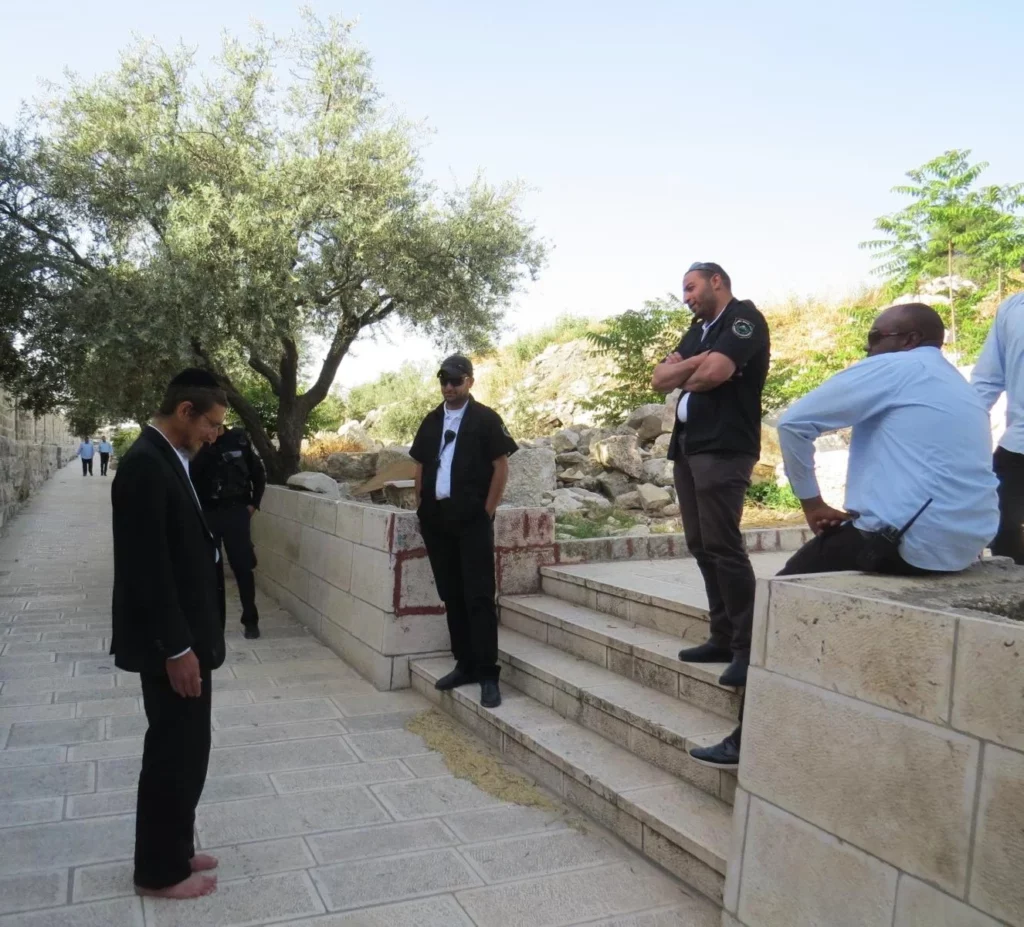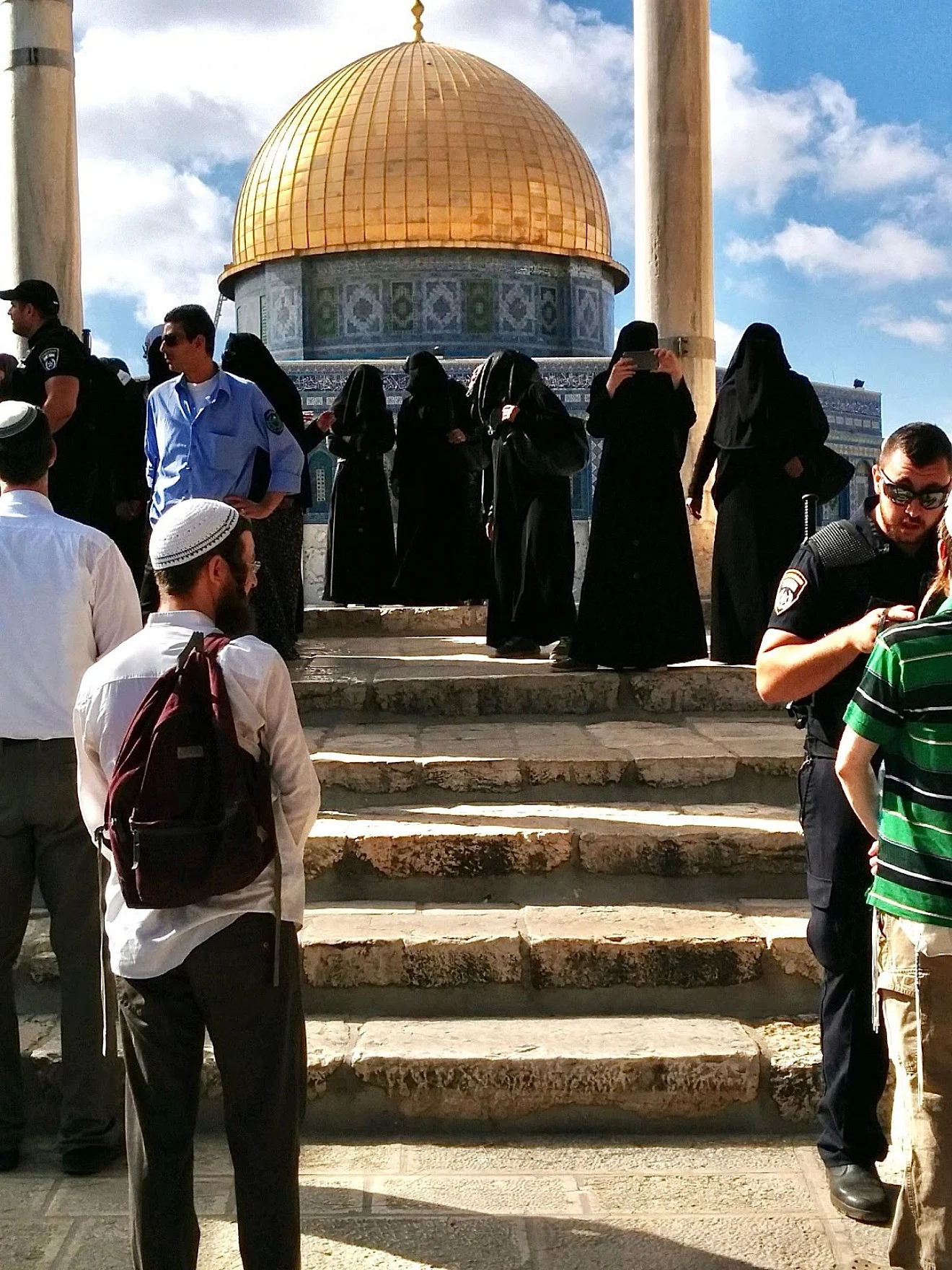I’d like to share with you a firsthand account of the long struggle to serve God on God’s mountain. I will describe what it was like as a Jew visiting Jerusalem’s Temple Mount (Har Habayit) to pray 10 years ago, what it is like now, what has changed, and why the recent change is so revolutionary.
The bad old days
When I first started going up to Har Habayit 11 years ago, Jewish pilgrims faced multiple obstacles to connecting with God.
First of all, Muslims on the mount would scream and curse at us. Some of the screamers were actually paid a salary to do so at the Jewish olim (those who have “gone up” or “ascended” to serve God to Har Habayit).
You can see a picture of the “professional” screamers in the following photo. They’re dressed in black from head to toe. To me, these women looked like black demons, standing between us and the sacred focus of our prayers beneath the dome.
The second major restriction was that Jews were not allowed to pray. Members of the Muslim guard, the Islamic Waqf, would accompany the groups of Jewish pilgrims and would watch our lips to make sure that we weren’t praying. The Israeli policemen also watched our lips and diligently enforced the prayer ban.
Thirdly, we were not allowed to bring any prayer book, Bible, or sacred text, even our own written prayers. When we were screened at the security checkpoint, the police would frisk us and search our bags to make sure we weren’t carrying any “contraband” sacred texts.
Fourthly, the Israeli police who accompanied and directed us were, for the most part, very unfriendly to the Jewish worshippers, and they would hurry us through our circuit of the mount.
Since we couldn’t move our lips, my way of serving God was to smile. I think all human beings naturally feel joy and love on Har Habayit, which is meant to be a place of prayer for everyone. Smiling is a great way to tap into that loving and joyful energy.
Below is a picture of the author on Har Habayit in 2015. All three of the men in front of me are members of the Muslim guard. Shortly after this picture was taken, the policeman standing to my left warned me “to stop smiling so much or he would kick me off the mountain.”
For me, this ridiculous suppression of a basic freedom—the freedom to pray—highlighted the immense significance of a Jew praying on “God’s Mountain,” and its centrality to Israel’s struggle with its enemies.
Our enemies point us towards the main battlefront
Consider the following:
- Hamas called its terrorist assault in southern Israel on Oct. 7, 2023, the “Al-Aqsa flood.” Al-Aksa is the main Muslim mosque on Har Habayit, and it has come to symbolize the entire area of Har Habayit, and Muslim authority over it.
- In every home in Gaza, Israeli soldiers found prominently displayed pictures and slogans related to Har Habayit.
- The main Palestinian terror organizations, including Hamas, have an image of the Dome of the Rock at the center of their emblems.
Our enemies have identified the Temple Mount as the most important battlefront in their war with Zionism. We need to pay attention to them. They understand—better than most of us who call ourselves Zionists—that the ultimate goal of Zionism is centered on Har Habayit.
To be an elite spiritual warrior
One of my sons in the Israel Defense Forces was badly injured in the war against Hamas in Gaza, and my eldest son just completed his sixth round of reserve duty. I will never match their sacrifice for our nation.
However, when Jews go up to honor and serve God on Har Habayit, we step into the role of a spiritual warrior in God’s “Sayeret” (elite forces), fighting for the Jewish nation and the God of Israel.
Fighting on this battlefront has challenges in addition to the restrictions on our prayer. One such challenge is the strong psycho-spiritual dissonance in the experience of making aliyah to Har Habayit. On the one hand, there is nothing more empowering than standing on God’s mountain, looking up at the sky and declaring, “Here I am, God. Two thousand years ago, Your prophets said I’d be back and, Here I am!”
On the other hand, it’s been 58 years since the Six-Day War in June 1967, when Israeli paratroopers declared that “the Temple Mount is in our hands.” Yet parts of this sacred place still look like a construction site, and the ridiculous restrictions that are still enforced on our freedom to pray here as a Jew make us want to scream in frustration.
Stages in the revolution
The first dramatic change for the better came in the wake of the murder of two Israeli policemen on Har Habayit on July 14, 2017. Immediately afterwards, the Israeli police expelled the people who screamed and cursed at the Jews. They also became less diligent about watching our lips, and we were allowed to pray openly, as long as we prayed modestly and responded to police instructions.
A small group of worshippers started going up daily. They gradually developed friendly relations with the police, and the police gradually came to respect the sincerity and commitment of the Jewish worshippers. Slowly, step by step, the situation improved. After a few years, Jews were finally allowed to pray communally (with a minyan or public prayer quorum of 10 or more). According to our sages, the Divine Presence rests on our communal prayers. Praying with a minyan on the mount is a powerful way to help move us towards our goal of returning the Divine Presence (Shechinah) to Zion.
The latest and most dramatic step forward was this last Tisha B’Av, Aug. 12, 2024, when Jews were for the first time allowed to prostrate fully, face down, arms and legs extended.
The first time Har Habayit is mentioned in the Bible is in the story of the Akedah, when Abraham takes his son Isaac up this mountain. Abraham tells his servants that they are going up Le-hish-ta-cha-vot to prostrate on Har Habayit. For our ancestors, the act of prostrating oneself before God was more fundamental than prayer as an act of connection and service, especially on Har Habayit.
Unlike prayer, which uses the mind and speech, prostration on the ground is a whole-body experience. On Har Habayit, our foreheads are in direct contact with the pavement, and our whole bodies are in direct contact with the earth. You can feel your heart pulsing against the earth, and as you pray, your lips are almost touching the pavement. This is a whole new and fully embodied avenue of soul expression that has been closed to our Jewish souls for two thousand years. Prayer is called the service of the heart. Hishtachavaya (full prostration) is a service of the whole self.

The big breakthrough and the question: Will it last?
Tisha B’Av is the day Jews mourn the destruction of the two holy temples, the Jewish people’s exile from our land and the exile of the Divine Presence from God’s home on Har Habayit. It is meant to be filled with reflection on the immensity of that loss and with yearning for the return of Jews to the land and the Shechinah to Zion.
This last Tisha B’Av was the first one after Oct 7, and the immensity of the Oct 7 calamity heightened the day’s intensity. All of us who went up to Har Habayit that day could feel the intensity of our loss and the intensity of our yearning for the Shechinah’s restoration, and we could not be held back. At a certain point early in our circuit of Har Habayit, we all loudly proclaimed God’s unity: Shema Yisrael, H’Eloheinu, H’Echad and immediately dropped down onto the paving stones. The police couldn’t stop us. Later that day, Internal Security Minister Itamar Ben-Gvir said publicly that Jews are allowed to prostrate.
In the days and weeks following Tisha B’Av, the police continued to allow us to prostrate. However, there were complaints from Muslim authorities and governments, and it was unclear where Israeli Prime Minister Benjamin Netanyahu and other ministers stood on the matter. All of us who came up to Har Habayit regularly were holding our breath, hoping that the government would not override Ben-Gvir and again forbid us from hishtachavaya, from prostration.
Netanyahu scheduled a meeting of ministers and security officials to discuss the issue. When I heard about this meeting, my heart sank, fearing that our “prostration-honeymoon” would soon end. The meeting was set for Sept. 17, the day of the “Grim Beeper” operation that decapitated Hezbollah in Lebanon. The meeting was canceled, and it has not been rescheduled. We are still able to fully bow and open ourselves up to connection with our Source.
We are privileged to live in a generation that can once again serve God on the Temple Mount. Those who “go up” to serve God there are especially privileged to play a central role in the biblical drama of restoring God’s Presence to Zion. Non-Jews can also participate in this holy work. Everyone who (after the proper preparations, including ritual immersion) goes up to Har Habayit to serve and honor the God of Israel is strengthening God’s presence on Earth and contributing to the healing and spiritual growth of our world.




